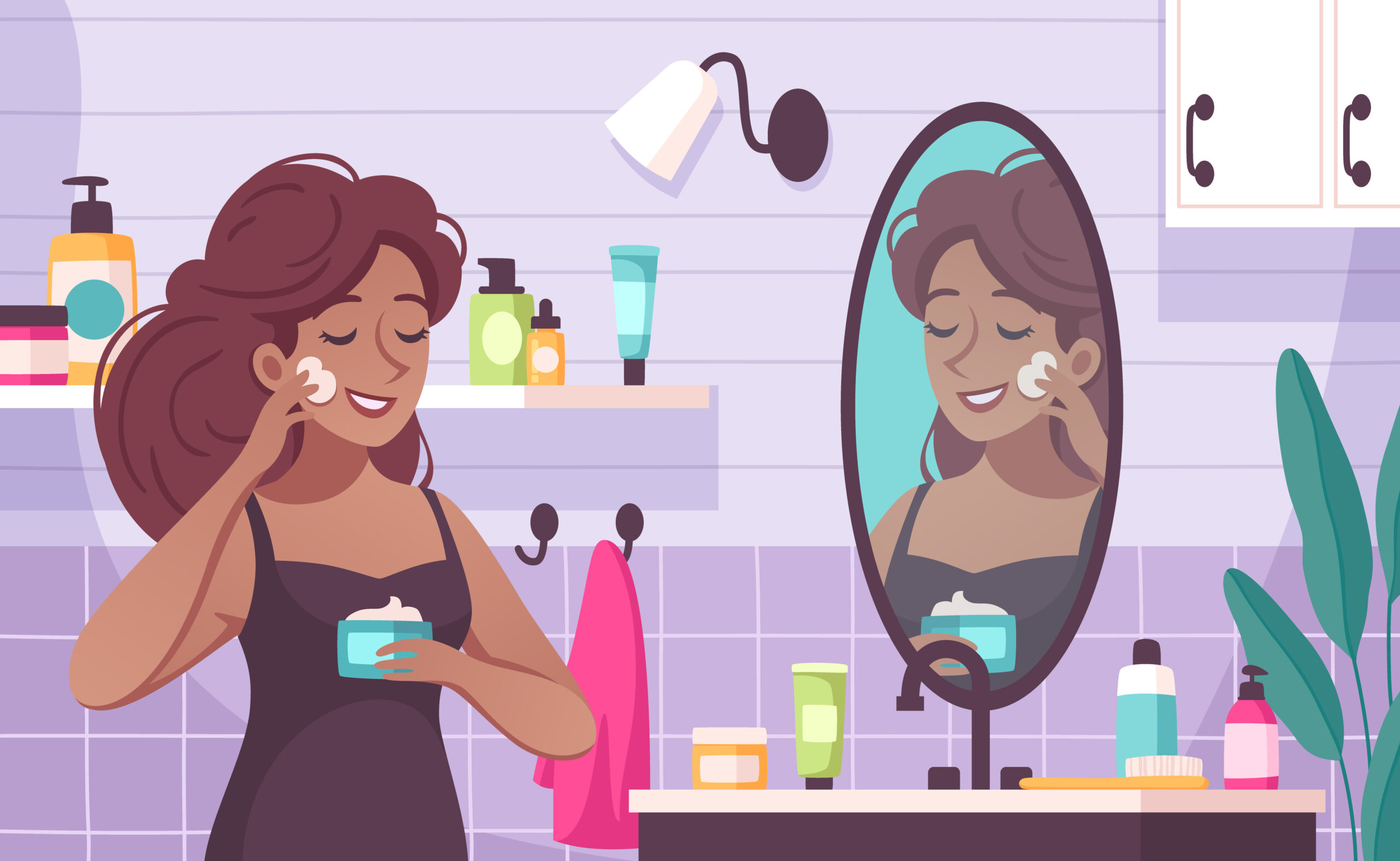Creating a skincare routine that suits your skin’s unique needs is essential for maintaining a healthy, glowing complexion. Whether you’re a skincare novice or a seasoned enthusiast, understanding the fundamentals of a well-structured skincare routine can help you achieve the best possible results. In this guide, we’ll break down the key steps of an effective skincare routine, discuss the importance of each step, and offer tips on how to tailor your regimen to your skin type.
Why a Skincare Routine Matters
Your skin is your body’s largest organ, and it’s constantly exposed to environmental stressors, pollution, and UV radiation. A consistent skincare routine helps to protect your skin from these external factors, keeps it hydrated, and addresses specific concerns such as acne, aging, or sensitivity.
Moreover, a well-structured skincare routine can:
- Prevent and treat skin problems: Consistent use of the right products can help prevent issues like breakouts, dryness, and premature aging.
- Promote healthy, glowing skin: A proper regimen can improve your skin’s texture and tone, giving you a radiant complexion.
- Boost your confidence: Clear, healthy skin can significantly enhance your self-esteem and confidence.
The Basic Steps of a Skincare Routine
A standard skincare routine consists of three fundamental steps: cleansing, toning, and moisturizing. However, depending on your skin type and concerns, additional steps such as exfoliation, treatment serums, and sun protection may be included.
- Cleansing
- Purpose: Cleansing is the first and most crucial step in any skincare routine. It removes dirt, oil, makeup, and impurities that accumulate on the skin throughout the day.
- How to Cleanse: Use a gentle cleanser suitable for your skin type. If you have dry or sensitive skin, opt for a hydrating or creamy cleanser. If your skin is oily, a foaming or gel cleanser may be more effective. Cleansing should be done twice a day—once in the morning and once before bed—to keep your skin fresh and clean.
- Toning
- Purpose: Toners help to remove any remaining traces of dirt and makeup after cleansing, balance the skin’s pH levels, and prepare the skin for the next steps in your routine.
- How to Tone: Apply toner to a cotton pad and gently swipe it across your face, focusing on areas prone to oiliness or dryness. Choose a toner based on your skin’s needs: hydrating toners for dry skin, balancing toners for oily skin, and calming toners for sensitive skin.
- Moisturizing
- Purpose: Moisturizers hydrate the skin and create a barrier that locks in moisture and prevents water loss. They are essential for maintaining skin’s elasticity and smoothness.
- How to Moisturize: After toning, apply a moisturizer that suits your skin type. For oily skin, choose a lightweight, oil-free moisturizer. For dry skin, opt for a richer, more emollient cream. Combination skin can benefit from a gel-based moisturizer on the oily areas and a creamier product on the drier areas.
- Sun Protection
- Purpose: Sunscreen is a non-negotiable step in any skincare routine, as it protects your skin from the harmful effects of UV radiation, which can cause premature aging, sunburn, and increase the risk of skin cancer.
- How to Apply: Apply a broad-spectrum sunscreen with at least SPF 30 as the final step in your morning routine. Reapply every two hours if you’re spending extended time outdoors.
Additional Steps to Enhance Your Skincare Routine
Depending on your skin’s needs, you may want to incorporate additional steps into your routine. These steps can target specific concerns such as acne, hyperpigmentation, aging, or dullness.
- Exfoliation
- Purpose: Exfoliation helps to remove dead skin cells from the surface of the skin, promoting cell turnover and revealing a smoother, brighter complexion. Regular exfoliation can also help prevent clogged pores and reduce the appearance of fine lines.
- How to Exfoliate: Exfoliate 1-3 times a week, depending on your skin type and the product you’re using. Chemical exfoliants, such as alpha hydroxy acids (AHAs) and beta hydroxy acids (BHAs), are generally gentler and more effective than physical scrubs. Avoid over-exfoliating, as it can lead to irritation and damage the skin barrier.
- Serums and Treatments
- Purpose: Serums are concentrated formulas designed to address specific skin concerns, such as wrinkles, hyperpigmentation, or acne. They contain active ingredients that penetrate deeper into the skin, providing targeted treatment.
- How to Use Serums: Apply serums after toning and before moisturizing. Choose a serum based on your skin’s needs: vitamin C serums for brightening, retinoids for anti-aging, or hyaluronic acid for hydration.
- Eye Cream
- Purpose: The skin around the eyes is thinner and more delicate than the rest of your face, making it more prone to dryness, fine lines, and puffiness. Eye creams are formulated to address these concerns.
- How to Apply: Gently pat a small amount of eye cream around the orbital bone using your ring finger. Look for eye creams with ingredients like peptides, caffeine, or hyaluronic acid to target specific issues.
- Masks
- Purpose: Face masks provide an intensive treatment for specific skin concerns. They can hydrate, detoxify, brighten, or soothe the skin, depending on the ingredients.
- How to Use Masks: Use a face mask 1-2 times a week as a treat for your skin. Clay masks are great for oily and acne-prone skin, while sheet masks and hydrating masks are ideal for dry or sensitive skin.
Tailoring Your Skincare Routine to Your Skin Type
Creating a personalized skincare routine that caters to your skin type is essential for achieving optimal results. Here’s how to tailor your regimen based on your skin type:
- Oily Skin
- Cleansing: Use a gentle foaming cleanser twice a day to control excess oil.
- Toning: Choose an alcohol-free toner with ingredients like salicylic acid or witch hazel to help balance oil production.
- Moisturizing: Opt for an oil-free, non-comedogenic moisturizer that hydrates without clogging pores.
- Sun Protection: Use a lightweight, mattifying sunscreen to reduce shine.
- Additional Tips: Exfoliate regularly to prevent clogged pores, and consider using a clay mask once a week to absorb excess oil.
- Dry Skin
- Cleansing: Use a hydrating, creamy cleanser that won’t strip your skin of its natural oils.
- Toning: Choose a hydrating toner with ingredients like hyaluronic acid or aloe vera to soothe and refresh your skin.
- Moisturizing: Opt for a rich, emollient moisturizer that deeply nourishes your skin.
- Sun Protection: Use a moisturizing sunscreen that provides hydration while protecting your skin.
- Additional Tips: Incorporate a hydrating serum and a weekly hydrating mask into your routine to boost moisture levels.
- Combination Skin
- Cleansing: Use a gentle, balancing cleanser that removes impurities without over-drying or over-hydrating the skin.
- Toning: Choose a toner that addresses both oily and dry areas, such as one with niacinamide or hyaluronic acid.
- Moisturizing: Use a lightweight moisturizer in the T-zone and a slightly richer one on the drier areas.
- Sun Protection: Use a broad-spectrum sunscreen that doesn’t leave a greasy residue.
- Additional Tips: Exfoliate regularly to prevent clogged pores in the T-zone, and use a hydrating mask on the drier areas.
- Sensitive Skin
- Cleansing: Use a mild, fragrance-free cleanser that won’t irritate or strip your skin.
- Toning: Choose a soothing toner with ingredients like rose water or chamomile that calm and hydrate the skin.
- Moisturizing: Opt for a hypoallergenic, fragrance-free moisturizer that soothes and protects the skin barrier.
- Sun Protection: Use a mineral sunscreen with zinc oxide or titanium dioxide, which are less likely to irritate sensitive skin.
- Additional Tips: Avoid products with alcohol, fragrance, or harsh chemicals, and always patch-test new products before incorporating them into your routine.
- Normal Skin
- Cleansing: Use a gentle, pH-balanced cleanser that maintains your skin’s natural barrier.
- Toning: Choose a hydrating or balancing toner that refreshes your skin without disrupting its balance.
- Moisturizing: Opt for a lightweight, non-greasy moisturizer that provides hydration without overwhelming your skin.
- Sun Protection: Use a broad-spectrum sunscreen with at least SPF 30.
- Additional Tips: Maintain a consistent routine to keep your skin balanced and healthy.
The Importance of Consistency
While it’s tempting to try new products and techniques frequently, consistency is key to seeing results in skincare. Give products time to work—typically, it takes about four to six weeks to see noticeable changes in your skin. Sticking to your routine allows your skin to adjust and respond to the products, leading to better outcomes in the long run.
Conclusion
An effective skincare routine is the foundation of healthy, radiant skin. By understanding the basic steps—cleansing, toning, moisturizing, and sun protection—and tailoring your routine to your specific skin type, you can address your unique concerns and maintain a glowing complexion. Remember, the best skincare routine is one that fits your lifestyle, meets your skin’s needs, and is practiced consistently. Whether you’re targeting specific issues or simply maintaining your skin’s health, a thoughtful skincare routine is your path to achieving and sustaining beautiful skin.




